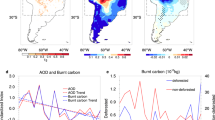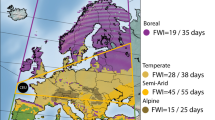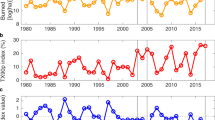Abstract
Much of the interannual variability in global atmospheric carbon dioxide concentrations has been attributed to variability of emissions from biomass burning1,2,3. Under drought conditions, burning in Indonesia is a disproportionate contributor to these emissions, as seen in the 1997/98 haze disaster1,4. Yet our understanding of the frequency, severity and underlying causes of severe biomass burning in Indonesia is limited because of the absence of satellite data that are useful for fire monitoring before the mid-1990s. Here we present a continuous monthly record of severe burning events from 1960 to 2006 using the visibility reported at airports in the region. We find that these fires cause extremely poor air quality conditions and that they occur only during years when precipitation falls below a well defined threshold. Historically, large fire events have occurred in Sumatra at least since the 1960s. By contrast, the first large fires are recorded in Kalimantan (Indonesian Borneo) in the 1980s, despite earlier severe droughts. We attribute this difference to different patterns of changes in land use and population density. Fires in Indonesia have often been linked with El Niño1,2,5,6,7,8,9,10,11,12, but we find that the Indian Ocean Dipole pattern is as important a contributing factor.
This is a preview of subscription content, access via your institution
Access options
Subscribe to this journal
Receive 12 print issues and online access
$259.00 per year
only $21.58 per issue
Buy this article
- Purchase on Springer Link
- Instant access to full article PDF
Prices may be subject to local taxes which are calculated during checkout




Similar content being viewed by others
References
Page, S. E. et al. The amount of carbon released from peat and forest fires in Indonesia during 1997. Nature 420, 61–65 (2002).
van der Werf, G. R. et al. Continental-scale partitioning of fire emissions during the 1997 to 2001 El Nino/La Nina period. Science 303, 73–76 (2004).
Langenfelds, R. L. et al. Interannual growth rate variations of atmospheric CO2 and its delta C13, H2, CH4, and CO between 1992 and 1999 linked to biomass burning. Glob. Biogeochem. Cycles 16, 10.1029/2001gb001466 (2002).
van der Werf, G. R. et al. Interannual variability in global biomass burning emissions from 1997 to 2004. Atmos. Chem. Phys. 6, 3423–3441 (2006).
Kita, K., Fujiwara, M. & Kawakami, S. Total ozone increase associated with forest fires over the Indonesian region and its relation to the El Niño-Southern oscillation. Atmos. Environ. 34, 2681–2690 (2000).
Bowen, M. R., Bompard, J. M., Anderson, I. P., Guizol, P. & Gouyon, A. in Forest Fires and Regional Haze in Southeast Asia (eds Eaton, P. & Radojevic, M.) 41–66 (Nova Science, 2001).
Heil, A. & Goldammer, J. G. Smoke-haze pollution: A review of the 1997 episode in Southeast Asia. Regional Environ. Change 2, 24–37 (2001).
Siegert, F., Ruecker, G., Hinrichs, A. & Hoffmann, A. A. Increased damage from fires in logged forests during droughts caused by El Nino. Nature 414, 437–440 (2001).
Kunii, O. et al. The 1997 haze disaster in Indonesia: Its air quality and health effects. Arch. Environ. Health 57, 16–22 (2002).
Wang, Y. H., Field, R. D. & Roswintiarti, O. Trends in atmospheric haze induced by peat fires in Sumatra Island, Indonesia and El Nino phenomenon from 1973–2003. Geophys. Res. Lett. 31, 10.1029/2003GL018853 (2004).
Aiken, S. R. Runaway fires, smoke-haze pollution, and unnatural disasters in Indonesia. Geogr. Rev. 94, 55–79 (2004).
Logan, J. A. et al. Effects of the 2006 El Nino on tropospheric composition as revealed by data from the Tropospheric Emission Spectrometer (TES). Geophys. Res. Lett. 35, 10.1029/2007GL031698 (2008).
Li, W. H. et al. Future precipitation changes and their implications for tropical peatlands. Geophys. Res. Lett. 34, 10.1029/2006GL028364 (2007).
Fargione, J., Hill, J., Tilman, D., Polasky, S. & Hawthorne, P. Land clearing and the biofuel carbon debt. Science 319, 1235–1238 (2008).
Field, R. D. & Shen, S. S. P. Predictability of carbon emissions from biomass burning in Indonesia from 1997 to 2006. J. Geophys. Res. 113, 10.1029/2008jg000694 (2008).
van der Werf, G. R. et al. Climate regulation of fire emissions and deforestation in equatorial Asia. Proc. Natl Acad. Sci. USA 105, 20350–20355 (2008).
Thompson, A. M. et al. Tropical tropospheric ozone and biomass burning. Science 291, 2128–2132 (2001).
Anshari, G., Kershaw, A. P. & van der Kaars, S. A late Pleistocene and Holocene pollen and charcoal record from peat swamp forest, Lake Sentarum Wildlife Reserve, West Kalimantan, Indonesia. Paleogeogr. Paleoclimatol. Paleoecol. 171, 213–228 (2001).
Saji, N. H., Goswami, B. N., Vinayachandran, P. N. & Yamagata, T. A dipole mode in the tropical Indian Ocean. Nature 401, 360–363 (1999).
Hong, C. C., Lu, M. M. & Kanamitsu, M. Temporal and spatial characteristics of positive and negative Indian Ocean dipole with and without ENSO. J. Geophys. Res. 113, 10.1029/2007JD009151 (2008).
Abram, N. J., Gagan, M. K., Mcculloch, M. T., Chappell, J. & Hantoro, W. S. Coral Reef death during the 1997 Indian Ocean dipole linked to Indonesian Wildfires. Science 301, 952–955 (2003).
Hendon, H. H. Indonesian rainfall variability: Impacts of ENSO and local air–sea interaction. J. Clim. 16, 1775–1790 (2003).
Juneng, L. & Tangang, F. T. Evolution of ENSO-related rainfall anomalies in Southeast Asia region and its relationship with atmosphere-ocean variations in Indo-Pacific sector. Clim. Dyn. 25, 337–350 (2005).
Vecchi, G. A. & Soden, B. J. Global warming and the weakening of the tropical circulation. J. Clim. 20, 4316–4340 (2007).
Notaro, M. Statistical identification of global hot spots in soil moisture feedbacks among IPCC AR4 models. J. Geophys. Res. 113, 10.1029/2007JD009199 (2008).
Hansen, M. C. et al. Humid tropical forest clearing from 2000 to 2005 quantified by using multitemporal and multiresolution remotely sensed data. Proc. Natl Acad. Sci. USA 105, 9439–9444 (2008).
Chen, M. Y., Xie, P. P., Janowiak, J. E. & Arkin, P. A. Global land precipitation: A 50-Yr monthly analysis based on gauge observations. J. Hydrometeorol. 3, 249–266 (2002).
Adler, R. F. et al. The Version-2 Global Precipitation Climatology Project (GPCP) monthly precipitation analysis (1979-Present). J. Hydrometeorol. 4, 1147–1167 (2003).
Stibig, H. J. et al. A land-cover map for South and Southeast Asia derived from SPOT-VEGETATION data. J. Biogeogr. 34, 625–637 (2007).
Smith, T. M. & Reynolds, R. W. Extended reconstruction of global sea surface temperatures based on COADS data (1854–1997). J. Clim. 16, 1495–1510 (2003).
Acknowledgements
We thank W. Spangler at the National Center for Atmospheric Research for assistance in processing the visibility data, C. Hong for assistance with Supplementary Section S5 and N. MacKendrick, K. Moore and B. de Groot for helpful reviews. R.D.F. was supported by a Natural Sciences and Engineering Research Council of Canada scholarship, and G.R.v.d.W. by a Veni grant from the Netherlands Organization for Scientific Research.
Author information
Authors and Affiliations
Contributions
R.D.F. conceived of the study and conducted the data analysis under the graduate supervision of S.S.P.S. All authors contributed to interpretation of the results and writing of the manuscript.
Corresponding author
Supplementary information
Supplementary Section S1
Supplementary Information (PDF 1107 kb)
Rights and permissions
About this article
Cite this article
Field, R., van der Werf, G. & Shen, S. Human amplification of drought-induced biomass burning in Indonesia since 1960. Nature Geosci 2, 185–188 (2009). https://doi.org/10.1038/ngeo443
Received:
Accepted:
Published:
Issue Date:
DOI: https://doi.org/10.1038/ngeo443
This article is cited by
-
Global seasonal prediction of fire danger
Scientific Data (2024)
-
Fire carbon emissions over Equatorial Asia reduced by shortened dry seasons
npj Climate and Atmospheric Science (2023)
-
Potential fire risks in South America under anthropogenic forcing hidden by the Atlantic Multidecadal Oscillation
Nature Communications (2022)
-
RETRACTED ARTICLE: New land-use-change emissions indicate a declining CO2 airborne fraction
Nature (2022)
-
The increased frequency of combined El Niño and positive IOD events since 1965s and its impacts on maritime continent hydroclimates
Scientific Reports (2022)



